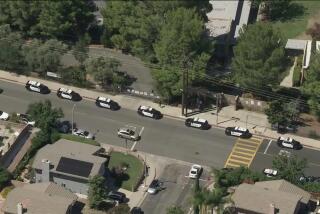Guns in the Book Bag: Pupils Find No Safe Haven--In or Out of Class
- Share via
NEW YORK — Alexander (Junior) Stevens traveled seven miles across the Bronx every morning to Alfred E. Smith High, an all-male vocational school known as a quiet place, a “safe” school.
Junior was shot to death outside the school cafeteria on Nov. 14; a 15-year-old classmate was charged. The boys were playing with a .22-caliber pistol and fired it accidentally, police said.
“There are plenty of safe schools all over the city where kids are sitting there with guns in their book bags. They just haven’t decided to shoot yet,” said Ed Muir, of the United Federation of Teachers, the teachers’ union.
Junior’s was the first killing in a city school since 1978, but in a system where violence is common, it seemed to have little effect on the other students.
“The thing that everyone was taken aback by is that the kids seem to be taking this so calmly. It’s just another kid whacked,” said Muir.
Bruce Irushalmi, director of the Board of Education Office of School Safety, said students “bring guns to school because they don’t feel safe going to and from school. . . . They say they need them to create a balance of power.”
Muir is more cynical. “Some kids feel they actually need it for protection, and some are businessmen who have large quantities of cash and thought it the prudent thing not to apply for a pistol permit.”
From September, 1988, to June, 1989, 1,854 weapons were seized at schools, from razor-edged box cutters to semiautomatic firearms. At 15 schools where teams of security guards used metal detectors, five guns and 815 other weapons were confiscated during the 1988-1989 school year--a year that saw 1,356 students assaulted, 183 robbed and 78 sexually assaulted. Figures for the current year were unavailable.
To balance the arms race, New York City spent $62 million on security in 1988, about 1% of its $7-billion budget. Metal detectors cost about $4 million of that; the rest supported 2,450 uniformed, but unarmed, security guards to police just under a million students.
“If we were a police force, we would be the 10th largest police force in the country,” Irushalmi said.
To Muir, that isn’t enough. He cites the increasingly frequent gun incidents--twice a week last year, 19 in the first 34 school days of this year--as evidence that the city’s schools are dangerous places. Figures kept by his union show a 5% increase in crime inside schools during the 1988-89 school year.
Preliminary figures for 1989 showed an 11% increase in school crime in September, and Muir said 44 teachers were assaulted during the first month of school last fall, compared to 27 during September, 1988.
But Irushalmi, whose two children attend public schools, says the problem is not inside the buildings. Reports of violence inside schools have fallen from 15,000 a year in 1981 to 9,000 in 1988-89. Outside, it is another story.
“For anyone under 18 this is Dodge City and you have to carry a piece,” he said. “Unfortunately, we don’t have Miss Kitty at the Long Branch to make sure you check your piece at the door.”
In one corner of this Dodge City, outside Prospect Heights High School in Brooklyn, a student was shot on the first day of school.
“There’s no safety in Prospect Heights,” even though there are spot checks with metal detectors, said Bob (Brother) Abu, 15. “If (guards) don’t come on Monday, they put the weapons in their lockers. So when the weapon detectors come on Wednesday, they have their weapons in the school already.”
“There ain’t no safety,” said his 17-year-old friend, who identified himself as Carl or Shrapnel Insepticon, a senior at Erasmus Hall High School in Brooklyn. He wore a blue bandanna over his lower face and said he was a member of the Decepticons, a street gang named after evil characters in “The Transformers,” cartoon show.
The loosely knit gang, which wears bandannas as identification, has been accused of taking part in Halloween rampages on Manhattan’s East Side, and in wolfpack-type attacks on students at bus and subway stations.
More than 100,000 students stayed away from school on Halloween, apparently out of fear. More than 250 high school-age youths were arrested as they roamed the streets robbing, intimidating and assaulting pedestrians and merchants.
Muir and the UFT have proposed some remedies: metal detectors in every school, police liaisons for junior high schools, stiffer penalties for carrying guns. But these steps, all agree, will not solve the underlying problems that lead to violence.
“The schools are a mirror of society,” Irushalmi said, citing the easy availability of weapons and “the diminution of values.”
“These kids don’t distinguish between the schools and the streets,” Muir said. “They don’t see any difference.”
“We really think it’s related to drugs. Part of it has to do with the sales, but another part is a lot of the kids’ parents are using drugs, and the kids are acting out,” said Gretchen Rausch, an assistant commissioner of the Probation Department who began her career as a probation officer in 1967.
Arrests of pupils ages 7 to 16 rose 27% from 1987 to 1988, she said.
The youngsters say there is no simple reason why they prey upon each other and their teachers.
Sean Chittick, 17, is a senior at Murry Bergtraum High School, across from police headquarters and regarded by many as one of the safest schools. Still, he sees violence all around him, and he is mystified.
“It just be happening for no type of reason,” he said. “Now they just be killing them for gold jewelry, or ‘You lookin’ at my girl.’ ”
More to Read
Sign up for Essential California
The most important California stories and recommendations in your inbox every morning.
You may occasionally receive promotional content from the Los Angeles Times.










